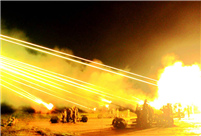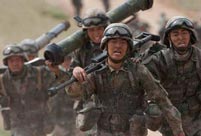

BEIJING, June 9 -- China's producer price index (PPI) slid 4.6 percent year on year in May, the 39th straight month of declines, official data showed on Tuesday.
The year-on-year drop in the PPI, a measure of costs for goods at the factory gate, matched April's, according to the National Bureau of Statistics (NBS).
On a monthly basis, the PPI contracted 0.1 percent in May, narrowing from a 0.3-percent decline in April, which was mainly caused by rising petroleum processing costs.
The 4.6-percent fall was the index's second-largest drop since its downward trend started in March 2012, suggesting continued weak market demand and adding deflationary pressure to the China's economy, HSBC chief China economist Qu Hongbin said.
NBS senior statistician Yu Qiumei attributed the dive mainly to price declines in coal, oil and gas exploration, oil refining and ferrous metal smelting.
Factory prices of production materials went down 5.9 percent in May, contributing 4.5 percentage points to the PPI drop. Factory prices for consumer goods also declined 0.3 percent, which contributed 0.1 percentage points to the drop.
The NBS also released data on growth in China's consumer inflation, which slowed to 1.2 percent in May from the 1.5 percent posted in April.
On Monday, official data showed China's export decline narrowed in May, while imports slumped 18.1 percent from the previous year.
The weak readings in May indicate that deflationary pressure and the real lending rate both remain high, according to a report by China International Capital Corporation (CICC).
"Monetary policy must remain on a loosening course until deflationary pressure eases and a more concrete recovery is under way," said CICC researcher Liu Liu.
The manufacturing purchasing managers' index (PMI), a key measure of factory activity in China, posted 50.2 in May, in expansion territory and up from 50.1 in April and March, official data showed earlier.
Analysts attributed the incremental improvement to central government easing measures.
China's GDPin 2014 grew 7.4 percent, the weakest annual expansion in 24 years.
In an effort to reduce financing costs and bolster the economy, China's central bank has cut the benchmark interest rates three times since November. The reserve requirement ratio (RRR), the amount of cash banks are required to hold as reserves, has also been cut twice this year.
 School life of students in a military college
School life of students in a military college PLA soldiers operate antiaircraft guns in drill
PLA soldiers operate antiaircraft guns in drill Mysterious “sky road” in Mount Dawagengzha
Mysterious “sky road” in Mount Dawagengzha J-11 fighters in air exercise
J-11 fighters in air exercise Top 16 Chinese cities with the best air quality in 2014
Top 16 Chinese cities with the best air quality in 2014 PLA helicopters travel 2,000 kilometers in maneuver drill
PLA helicopters travel 2,000 kilometers in maneuver drill PLA soldiers conduct 10-kilometer long range raid
PLA soldiers conduct 10-kilometer long range raid Stars who aced national exams
Stars who aced national exams
 Hefei-Fuzhou railway line put into trial operation
Hefei-Fuzhou railway line put into trial operation Pain lingers as nation mourns lost lives
Pain lingers as nation mourns lost lives The social media breakup
The social media breakup Parents willing to pay millions for substitute gaokao takers
Parents willing to pay millions for substitute gaokao takers Mind the gaps: Post-70, 80 and 90 generations
Mind the gaps: Post-70, 80 and 90 generationsDay|Week